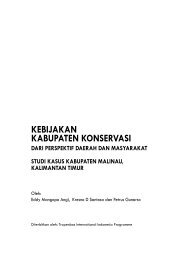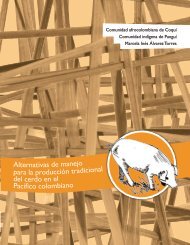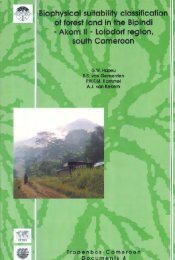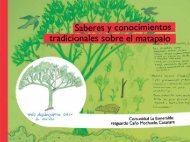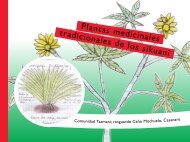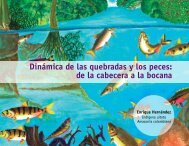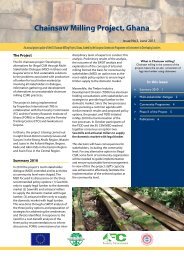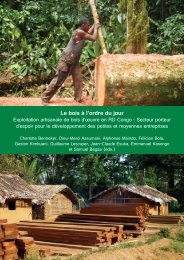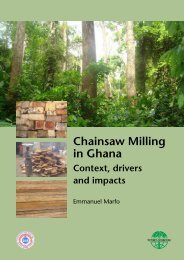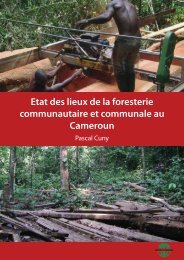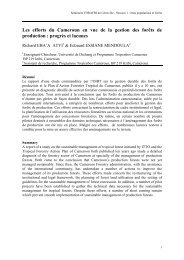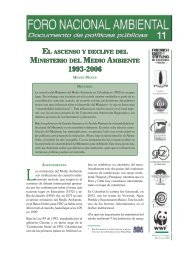Download the publication - Tropenbos International
Download the publication - Tropenbos International
Download the publication - Tropenbos International
Create successful ePaper yourself
Turn your PDF publications into a flip-book with our unique Google optimized e-Paper software.
Biodiversity hotspots and conservation priorities in Central African rain forests<br />
importance, since we feel that <strong>the</strong> plants of Campo-Ma’an are of global importance. In<br />
total, 141 species of high conservation priority and 92 threatened species listed in <strong>the</strong><br />
IUCN (2002) and WCMC (1998) were identified for <strong>the</strong> Campo-Ma’an area (Tables<br />
5.6 & 5.7). Of <strong>the</strong> 29 strict endemic species that are only known from <strong>the</strong> Campo-<br />
Ma’an area, 17 were not recorded in <strong>the</strong> National Park illustrating <strong>the</strong> need for<br />
conservation activities outside <strong>the</strong> park. Their distribution patterns showed a high<br />
concentration of species around Campo, Lobe, Massif des Mamelles, Mont d’Eléphant<br />
and Zingui and a very poor representation in <strong>the</strong> Ma’an area (Figure 5.2). Although<br />
<strong>the</strong>se 17 strict endemics are not immediately threatened with extinction, <strong>the</strong> most<br />
threatened are probably those occurring in <strong>the</strong> coastal zone and in areas located at <strong>the</strong><br />
vicinity of large agro-industrial plantations, since <strong>the</strong>se areas are heavily exploited. As<br />
shown in Figure 5.5, <strong>the</strong>ir habitats are fragmented and degraded because <strong>the</strong>se areas<br />
are surrounded by farms and heavily disturbed forests.<br />
Taking into consideration <strong>the</strong> fact that extinct species are taxa that are no longer<br />
known to exist in <strong>the</strong> world after repeated search in <strong>the</strong>ir type localities (WCMC,<br />
1998; IUCN, 2002), we can not yet talk about extinction because no attempt has been<br />
made to search for <strong>the</strong>se species. Fur<strong>the</strong>rmore, only 67% of <strong>the</strong> total amount of<br />
specimens collected were identified at species level. However, with <strong>the</strong> ongoing speed<br />
of forest degradation noticed in <strong>the</strong> coastal area, 8 of <strong>the</strong>se strict endemics<br />
(Beilschmiedia dinklagei, Deinbollia macroura, Ledermanniella batangensis,<br />
Psychotria aemulans, P. batangana, P. dimorphophylla, P. oligocarpa, and Strychnos<br />
canthioides) that are only known from <strong>the</strong> coastal zone can be categorised as<br />
endangered species. While <strong>the</strong> 9 o<strong>the</strong>rs that are located inland around Efoulan, Fenda,<br />
Massif des Mamelles, Mont d’Eléphant and Zingui can be categorised as vulnerable.<br />
They are Afrotrewia kamerunica, Bulbophyllum alinae, Begonia montis-elephantis,<br />
Calvoa stenophylla, Dorstenia dorstenioides, Guaduella mildbraedii, Hypolytrum sp.<br />
nov., Scaphopetalum acuminatum and S. brunneo-purpureum. Some of <strong>the</strong>m so far<br />
are only known from type specimens or from a few collections made in <strong>the</strong> type<br />
locality before <strong>the</strong> 60s. O<strong>the</strong>rs such as Afrotrewia kamerunica, Begonia montiselephantis<br />
and Hypolytrum sp. nov. have a restricted range with a small and restricted<br />
population. Fur<strong>the</strong>rmore, habitat fragmentation may convert a previously more<br />
continuous population structure to a metapopulation structure, with local populations<br />
becoming so small that <strong>the</strong>y may have a substantial risk of extinction (Hawksworth &<br />
Kalin-Arroyo, 1995).<br />
Implications for biodiversity conservation<br />
The Campo-Ma’an National Park<br />
The National Park is <strong>the</strong> core conservation area of <strong>the</strong> Campo-Ma’an Technical<br />
Operational Unit. It is surrounded by areas under several land uses that have varying<br />
ecological impact on <strong>the</strong> park and <strong>the</strong> surrounding forests. The park is of high<br />
conservation priority with about 72% of <strong>the</strong> 2297 species of vascular plants, ferns and<br />
fern allies recorded so far in <strong>the</strong> Campo-Ma’an area. More than 70% of <strong>the</strong> total<br />
endemic species recorded were also found in <strong>the</strong> National Park, and most of <strong>the</strong> forest<br />
types with high GHI scores, low PI scores and high conservation priority species were<br />
also found in <strong>the</strong> park (Figures 5.3 & 5.7). The most important one is <strong>the</strong> endemic<br />
lowland evergreen forest rich in Caesalpinioideae with Calpocalyx heitzii and<br />
Sacoglottis gabonensis, a vegetation type that only occurs in <strong>the</strong> Campo area<br />
101



